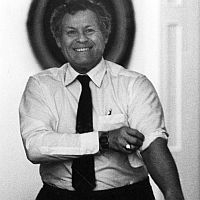
(Host) At a recent forum, two of this year’s Democratic gubernatorial candidates surprised a group of the state’s business leaders. They listed former Republican Dick Snelling as the governor that they’d like to model their own gubernatorial careers after.
Snelling made a key decision in the winter of 1991. And, as VPR’s Bob Kinzel explains, that’s what inspires these two Democratic candidates almost 20 years later.
(Kinzel) This all boils down to taxes and spending.
When Dick Snelling was sworn into office in January of 1991, the state was facing an $80 million budget deficit.
The shortfall represented about the same percentage of the state’s overall budget as this year’s projected deficit – between 10 and 15 percent of all spending.
Snelling’s election in 1990 was his second experience as governor – he served four terms between 1977 and 1984.
In 1991, Snelling formed a very unusual political alliance. The Republican governor joined together with Democratic House Speaker Ralph Wright to support a deficit reduction package that included tax increases and budget cuts.
At a press conference that winter, Snelling said it was essential for lawmakers to adopt the package and he said he was willing to take full responsibility for it:
(Snelling) "I’m perfectly willing, if I can get this problem solved, to be a one term governor. That won’t hurt me an awful lot if the price of getting this problem solved is that I’m unpopular. I’ll live with that."
(Kinzel) Many House Republicans were very angry at Snelling for supporting tax increases and they demanded that the package be changed. Snelling refused:
(Snelling) "Now if I have a right to say, ‘Well, ok, I want to buy all of it except this piece that I don’t like,’ well then they have a right to buy all of it except the piece they don’t like. And where are we then?"
(Kinzel) At a heated party caucus at the Statehouse, Snelling laid it on the line. If a majority of House Republicans didn’t support the package, he would no longer consider himself to be their leader:
(Snelling) "I will be clearly unable to lead you if the Democrats bring a majority of their party to support a package that has had all this discussion between the speaker and myself and the Republicans won’t come towards the center to the same degree. I will have failed."
(Kinzel) Democratic gubernatorial candidate Doug Racine says he was inspired by Snelling’s approach.
Racine was Senate president in 1991. He says Snelling urged him to join a trip to New York City to meet with Wall Street bond managers to discuss the state’s deficit plan.
Recently, Racine told the story to a group of business leaders:
(Racine) "It wasn’t about Democrats versus Republicans or Independents or Progressives. It was that we were all Vermonters. We’re all elected officials and we had a job to do and we figured out how to do it together. And to me that’s an inspiration and that’s a model for how I would like to see state government work."
(Kinzel) Democratic candidate Peter Shumlin also told the group that Snelling’s business experience serves as an important model for him:
(Shumlin) "Dick Snelling had run a business. That’s why he managed the state well. I think one of Vermont‘s challenges is that it hasn’t had a governor who has run a business since Dick Snelling. That’s not where our governors have come from."
(Kinzel) UVM political science professor Garrison Nelson thinks there’s a key reason why Racine and Shumlin are stressing a bipartisan approach:
(Nelson) "I think that’s what these candidates are hoping to tap into. And nobody wins election in Vermont with just members of your party alone. So you need people the Independents and people from the other party to get you over that electoral hump."
(Kinzel) And Nelson views Snelling’s decision to back a deficit plan that included tax increases as an act of political courage:
(Nelson) "The ambitions had been put aside and he was concerned with how he would be regarded in the eyes of the state. And I think this was a legacy decision and one in a sense that did enhance his legacy, and I think part of the reason we have two Democrats willing to cite this is proof that it succeeded."
(Kinzel) Not everyone sees the parallels between 2010 and 1991. Chittenden Senator Diane Snelling is the former governor’s daughter. She doesn’t think the analogy works:
(Diane Snelling) "I just need to correct the record here. So many people have said to me, ‘Oh, Diane, your father did this. He raised taxes temporarily.’ Well, the situation is, in my opinion, extremely different. When in 1991 the overall tax burden was something in the neighborhood of 6 percent, we’re now over 9 percent. And the circumstance is totally different. The world is very unpredictable and much more global than it was in ’91."
(Kinzel) But the Democratic candidates know it’s smart to affiliate themselves with a respected Republican. Consider the electoral math. When Republican Governor Jim Douglas was elected to a fourth term in 2008, roughly a third of his voters also cast a ballot for Democratic President Barack Obama.
Republican gubernatorial candidate Brian Dubie and the five Democrats running for governor this year understand the importance of that kind of bipartisan vote splitting. And they’re hoping to follow Douglas’s lead and make significant inroads with voters of the opposite party in order to be elected.
For VPR News, I’m Bob Kinzel in Montpelier.